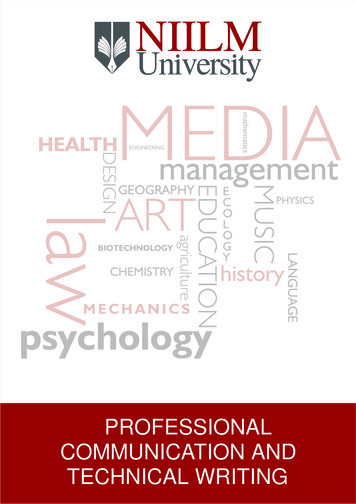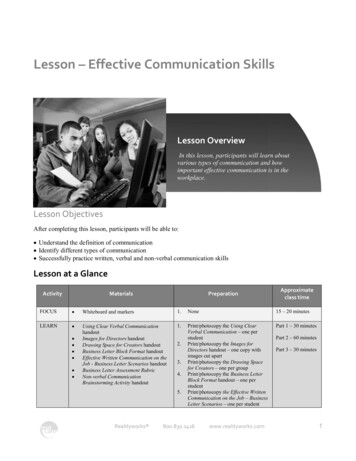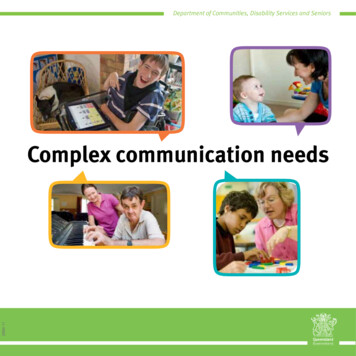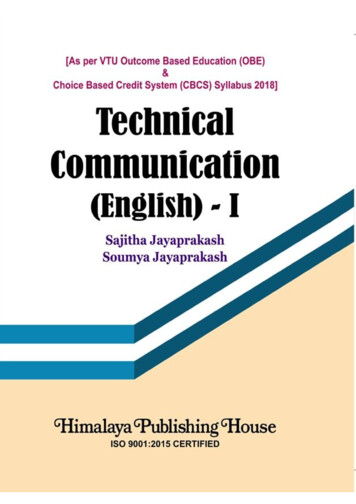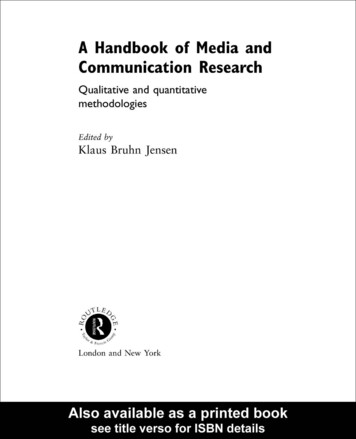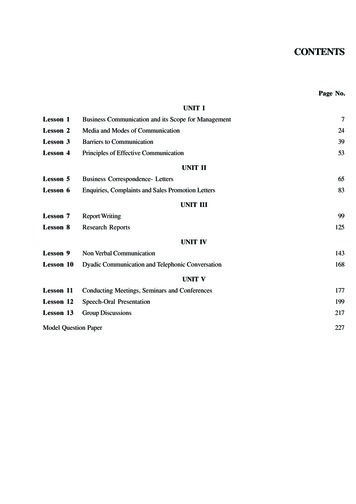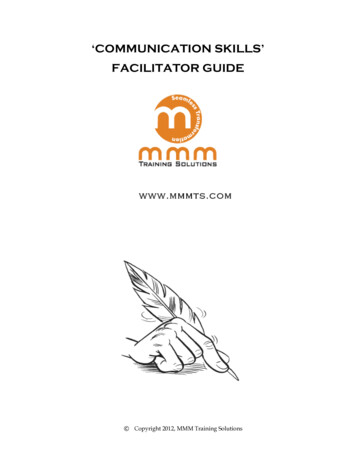
Transcription
Michael J. Klein , is Associate Professor of writing, rhetoric and technical communication at James Madison University, where he directsthe Cohen Center for the Humanities, a university center focused onhumanistic inquiry across disciplines and the support of graduate education through scholarships, travel grants and learning opportunities.He teaches courses in technical communication, scientific and medicalcommunication, and writing in the health sciences. His recent scholarship has focused on medical narratives and intercultural communication, and the creation of graphic embodiment memoirs in an interdisciplinary writing course. .EFFECTIVE TEACHINGDrawn from quantitative and qualitative work of practitioners in thefield, this edited collection provides an update to the Staples and Ornatowski’s inf luential Foundations of Teaching Technical Communication(1997). The collection is organized around the broad themes of expanding pedagogy, shaping curriculum, incorporating technology, and engaging community. In each section, authors illustrate their experienceswith teaching in the university technical communication classroom, addressing topics such as rethinking the role of internships, redesigningstudent learning outcomes for assessment practices, incorporating ethicsinto the technical communication classroom, using visual communication in community context, and engaging plain language. These sixteenchpaters, taken as a whole or individually, provide readers with insightsand examples into teaching technical communication in the 21st century.Michael J. KleinEffective Teaching of Technical CommunicationEffective Teaching ofTechnical CommunicationTheory, Practice, and ApplicationPractice & PedagogySeries Editor: Lisa MelonçonThe WAC ClearinghouseFort Collins, CO 80523wac.colostate.eduEdited by Michael J. KleinWUniversity Press of ColoradoLouisville, Colorado 80027upcolorado.comISBN 978-1-64215-112-1WFoundations and Innovations in Technicaland Professional Communication
EFFECTIVE TEACHING OFTECHNICAL COMMUNICATIONTHEORY, PRACTICE, AND APPLICATION
Foundations and Innovations in Technicaland Professional CommunicationSeries Editor: Lisa MelonçonSeries Associate Editors: Kristin Marie Bivens and Sherena HuntsmanThe Foundations and Innovations in Technical and Professional Communication series publishes work that is necessary as a base for the field of technical and professional communication (TPC), addresses areas of central importance within the field, and engages with innovative ideas and approaches toTPC. The series focuses on presenting the intersection of theory and application/practice within TPC and is intended to include both monographs andco-authored works, edited collections, digitally enhanced work, and innovative works that may not fit traditional formats (such as works that are longerthan a journal article but shorter than a book).The WAC Clearinghouse, Colorado State University Open Press, and University Press of Colorado are collaborating so that these books will be widelyavailable through free digital distribution and low-cost print editions. Thepublishers and the series editors are committed to the principle that knowledge should freely circulate. We see the opportunities that new technologieshave for further democratizing knowledge. And we see that to share the power of writing is to share the means for all to articulate their needs, interests,and learning into the great experiment of literacy.
EFFECTIVE TEACHING OFTECHNICAL COMMUNICATIONTHEORY, PRACTICE, AND APPLICATIONEdited by Michael J. KleinThe WAC Clearinghousewac.colostate.eduFort Collins, ColoradoUniversity Press of Coloradoupcolorado.comBoulder, Colorado
The WAC Clearinghouse, Fort Collins, Colorado 80523University Press of Colorado, Boulder, Colorado 80027 2021 by Michael J. Klein. This work is licensed under a Creative Commons AttributionNonCommercial-NoDerivatives 4.0 International.ISBN 978-1-64215-112-1 (PDF) 978-1-64215-113-8(ePub) 978-1-64642-189-3 (pbk.)DOI 10.37514/TPC-B.2021.1121Produced in the United States of AmericaLibrary of Congress Cataloging-in-Publication DataNames: Klein, Michael J., 1969- editor.Title: Effective teaching of technical communication : theory, practice, and application / edited byMichael J. Klein.Description: Fort Collins, Colorado : The WAC Clearinghouse ; Boulder, Colorado : UniversityPress of Colorado, [2021] Series: Foundations and innovations in technical and professionalcommunication Includes bibliographical references and index.Identifiers: LCCN 2021003565 (print) LCCN 2021003566 (ebook) ISBN 9781646421893(paperback) ISBN 9781642151121 (adobe pdf ) ISBN 9781642151138 (epub)Subjects: LCSH: Communication of technical information--Study and teaching.Classification: LCC T10.5 .E345 2021 (print) LCC T10.5 (ebook) DDC 601/.4076--dc23LC record available at https://lccn.loc.gov/2021003565LC ebook record available at https://lccn.loc.gov/2021003566Copyeditor: Meg VezzuDesigner: Mike PalmquistSeries Editor: Lisa MelonçonSeries Associate Editors: Kristin Marie Bivens and Sherena HuntsmanThe WAC Clearinghouse supports teachers of writing across the disciplines. Hosted by ColoradoState University, and supported by the Colorado State University Open Press, it brings togetherscholarly journals and book series as well as resources for teachers who use writing in their courses.This book is available in digital formats for free download at wac.colostate.edu.Founded in 1965, the University Press of Colorado is a nonprofit cooperative publishing enterprisesupported, in part, by Adams State University, Colorado State University, Fort Lewis College,Metropolitan State University of Denver, University of Colorado, University of NorthernColorado, Utah State University, and Western Colorado University. For more information, visitupcolorado.com.
ContentsIntroduction to Effective Teaching of Technical Communication. . . . . . . . 3Michael J. KleinPart One: Expanding Pedagogy. . . . . . . . . . . . . . . . . . . . . . . . . . . . . 111. Beyond Situated Learning: Rethinking Internship Theory andPractice in the Distributed Workplace. . . . . . . . . . . . . . . . . . . . . . . . . . . . 13Jennifer L. Bay2. Interstitial Design Processes: How Design Thinking and SocialDesign Processes Bridge Theory and Practice in TPC Pedagogy . . . . . . . 29Liz Lane3. Engaging Plain Language in the Technical CommunicationClassroom. . . . . . . . . . . . . . . . . . . . . . . . . . . . . . . . . . . . . . . . . . . . . . . . . 45Kira Dreher4. (Teaching) Ethics and Technical Communication . . . . . . . . . . . . . . . . 67Derek G. RossPart Two: Shaping Curriculum . . . . . . . . . . . . . . . . . . . . . . . . . . . . . 895. Confronting Methodological Stasis: Re-Examining Approachesto Technical Communication Pedagogical Literacy Frameworks . . . . . . . 91Halcyon M. Lawrence and Liz Hutter6. Trial and Error: Designing an Introductory Course to TechnicalCommunication. . . . . . . . . . . . . . . . . . . . . . . . . . . . . . . . . . . . . . . . . . . . 111Chen Chen7. Regenerating a Once Fallow Ground: Theorizing Process andProduct in 21st-Century Technical Communication Ecologies. . . . . . . . 131Adrienne Lamberti and David M. Grant8. Creating the “Through-Line” by Engaging Industry CertificationStandards in SLO Redesign for a Core Curriculum TechnicalWriting Course. . . . . . . . . . . . . . . . . . . . . . . . . . . . . . . . . . . . . . . . . . . . 147Julianne Newmark and Joseph BartolottaPart Three: Incorporating Technology. . . . . . . . . . . . . . . . . . . . 1679. The Rhetoric, Science, and Technology of 21st Century Collaboration.169Ann Hill Duin, Jason Tham, and Isabel Pedersenv
10. Using the Community of Inquiry Theory to Assess OnlinePrograms and Help Students to Analyze Their Learning . . . . . . . . . . . . 193Julie Watts11. Designing a Team-Based Online Technical CommunicationCourse. . . . . . . . . . . . . . . . . . . . . . . . . . . . . . . . . . . . . . . . . . . . . . . . . . . 209Luke Thominet12. Preparing Future Professionals in and for a Global Context:A Case for Telecollaborative Educational Initiatives. . . . . . . . . . . . . . . . 231Elisabet Arnó-Macià and Tatjana SchellPart Four: Engaging Communities. . . . . . . . . . . . . . . . . . . . . . . . . 25313. Visual Communication in Community Contexts . . . . . . . . . . . . . . . 255Elise Verzosa Hurley14. Competing Mentalities: Situating Scientific Content LiteracyWithin Technical Communication Pedagogy. . . . . . . . . . . . . . . . . . . . . 271Lisa DeTora15. Technical Communication Pedagogy and Layered Literaciesin Workplace Training Courses . . . . . . . . . . . . . . . . . . . . . . . . . . . . . . . 287Elizabeth L. Angeli16. Hidden Arguments: Rhetoric and Persuasion in Diverse Formsof Technical Communication . . . . . . . . . . . . . . . . . . . . . . . . . . . . . . . . . 303Jessica McCaughey and Brian FitzpatrickContributors . . . . . . . . . . . . . . . . . . . . . . . . . . . . . . . . . . . . . . . . . . . . . . 319Index. . . . . . . . . . . . . . . . . . . . . . . . . . . . . . . . . . . . . . . . . . . . . . . . . . . . 325
EFFECTIVE TEACHING OFTECHNICAL COMMUNICATIONTHEORY, PRACTICE, AND APPLICATION
Introduction to Effective Teachingof Technical CommunicationMichael J. KleinJames Madison UniversityExigency for a New CollectionKatherine Staples and Cezar M. Ornatowski’s Foundations for Teaching TechnicalCommunication (1997) has served and still serves as an entry point into the discipline for many students. Because of its influence, Foundations also serves as aconceptual starting point for this collection. However, much has changed in thepast 24 years: the institutional structures that support and house technical communication programs, the social and technical contexts in which technical communicators do their work, and the discourse communities technical communicators engage with. These new dynamics have manifested in a number of ways andprovided us with the impetus to develop a new collection to reflect these changes.Over the past two decades, the field of technical and professional communication (TPC) has continued to flourish, with degree programs of all types inTPC at four-year institutions experiencing a 17 percent growth rate in the lastfive years (Melonçon & Schreiber, 2018). Given this growth, it is important thatwe reflect upon what and how we are teaching students who will become the nextgeneration of technical communicators. This collection brings together diversescholarly voices and perspectives in both freestanding technical communicationprograms and as part of larger departments. By doing so, the collection endeavors to broaden our understanding of current effective teaching and pedagogicalmethods by facilitating a discussion of important and innovative theories, concepts, and practices related to the teaching of technical communication.Thus, in this new collection, we seek to address the similar overarching themesof theory, practice, and application that Staples and Ornatowski’s foundationalwork grappled with over 20 years ago in light of the changes that have accompanied the growth of the field. Three primary changes guide the structure andmakeup of this work.First, there has been a need for more attention to issues of accessibility andinclusivity as the audiences we communicate with are more varied and are moreglobally and culturally diverse (Melonçon, 2013/2017; Thatcher & St.Amant,2011). For example, one way this is evidenced in the technical communication(TC) literature is by the field’s social justice turn. Writing in their 2019 monograph Technical Communication After the Social Justice Turn, authors Rebecca WalDOI: https://doi.org/10.37514/TPC-B.2020.1121.1.33
ton, Kristen Moore, and Natasha N. Jones explain that “[a] turn comprises notonly a wave of scholarship engaging with a particular concept, theory, or topicbut also a more substantial shift, a transformation in thinking and meaning making” (6). While acknowledging that “[t]he precise beginning point of such a turnis debatable” (7), they trace the turn back to the work of Carolyn Rude (2009)mapping the field of technical communication. Selections in the first part of thiscollection—Expanding Pedagogy—address these and other issues related to expanding our curriculum to be more inclusive and comprehensive.Second, as previously mentioned, we have seen the growth of technicalcommunication programs, especially as stand-alone units in universities andcolleges. This, in turn, has allowed us to change the way we teach. For example,we now have more freedom to design our curricula without having to accede tothe constraints/directives of other disciplines such as English literature, composition, or engineering (Melonçon & Henschel, 2013). Selections in the second part of the collection—Shaping Curriculum—grapple with the advantagesand added responsibilities we encounter as our field maintains its independenceand grows.Third, there has been a significant rise in the use of communication technologies, especially the use of social media by professional organizations, governmental organizations, and universities. This greater variety of technologiesmeans designing for different platforms and writing for more varied audiences inspecialized contexts (Hea, 2013; Vie, 2017). Furthermore, as online and electroniccollaboration across cultures and national borders have become more commonplace, the way organizations communicate internally and with their constituents/clients has also changed, thus increasing specialization of both program foci andemployment positions (Andersen, 2013; Virtaluoto et al. , 2016). Selections in thethird—Incorporating Technology—and the fourth—Engaging Communities—parts of the collection provide readers with examples of how these technologiescan be leveraged both in the traditional academic classroom as well as whenworking with external communities.These changes have altered the tools that technical communicators use andthe situations and contexts in which the tools are used (Hovde & Renguette,2017; Wilson & Wolford, 2017). We have also seen changes expand the organizational need for those proficient in the latest technical communication bestpractices (Brumberger & Lauer, 2015). Additionally, the workplace itself haschanged: no longer relegated to a physical space and set hours, the traditionaloffice has expanded its confines as telecommuting and virtual interaction become more commonplace (Ferro & Zachry, 2013; Frith, 2017; Wilson & Wolford, 2017). This has especially been evident in 2020 as the COVID-19 pandemichas forced us to move our teaching into a virtual environment with little to nowarning and required us to confront assumptions about teaching that guide ourpedagogy (Williamson et al., 2020).4
About This CollectionThe 16 chapters collected here coalesce around four topics: expanding pedagogy, shaping curriculum, incorporating technology, and engaging communities.Through a diverse collection of methods and perspectives, the authors providereaders with concrete suggestions and examples of how to reconceptualize, revise,and reimplement their teaching in technical communication courses that growbeyond the traditional four walls of the college classroom. Readers are invited touse any or all of these writings to aid them in teaching the next generation oftechnical writers, editors, and communicators.Part One: Expanding PedagogyThe selections in the first part of this collection address the need to follow thesocial justice turn in TC as we reflect and revise our pedagogical curriculum. Theyexamine ways in which we can broaden the types of pedagogy we employ in theclassroom through a focus on social justice, among other topics ( Jones, 2016).In her chapter on situated learning, Jennifer L. Bay retheorizes internships asrhetorical opportunities for students to learn soft skills. She argues that the internship course and experience typically employed by the programs allow students tolearn these skills so they can be competitive and successful in the global workplace.Liz Lane’s discussion of interstitial design processes—the blending of several design theories into one for use in the TC classroom—posits that such anapproach is appropriate for teaching issues of social justice, which have beenrecently shaping our field’s research and pedagogy. She does so by offering anexample of how an assignment based in interstitial design can be combined withgenre-based assignments with a social justice focus.In her examination of plain language, Kira Dreher encourages instructors touse plain language strategies in TC courses, as plain language strategies overlapwith aims of technical communication. By offering specific in-class applicationson the use of plain language, she demonstrates how expertise in TC lends itselfwell to engaging with the plain language movement.Finally, Derek G. Ross suggests that the incorporation of instruction onethical decision-making into our classrooms helps us better teach students howunderstanding how we make decisions allows us to better communicate our decisions to others. A rich version of ethics decision-making, which he proposes,would consider multiple ethical models, including feminist ethics and ethics ofcare, when seeking to creatively solve problems.Part Two: Shaping CurriculumThe chapters found in this part of the collection deal with curricular development,both at the course and program level, for new approaches to TC instruction. They5
also demonstrate the practical application of using reimagined TC theories—likelayered literacies (Cargile Cook, 2002)—in the classroom and learning environments (e.g., Bourelle et al., 2015; Sapp & Crabtree, 2002) that technical communicators use to train the next generation of practitioners.In the first chapter in part two, Halcyon Lawrence and Liz Hutter call oninstructors to critically engage with how the field develops and uses pedagogicalliteracy frameworks. Rather, they argue that because of our field’s growth, thereneeds to be an inclusion of other qualities, including responsiveness, multidimensionality, and sustainability.Next, Chen Chen examines her experiences in developing an introductorycourse in technical communication for a university without a technical communication degree program. Chen discusses how a class with a problem-solving perspective and social justice orientation helps students develop the core conceptualskills of TC.Adrienne Lamberti and David Grant discuss how TC pedagogy often privileges application at the expense of theory. In participating in their program’s curricular revision, the two found that a balance of theory and practice helped facultydevelop a theoretical framework that embodied ecologies of practice and civility.In the final chapter of this section, Julianne Newmark and Joseph Bartolotta recount the development of new student learning outcomes (SLOs) for asophomore-level TC course. Their work provides insights into developing SLOsthrough the engagement of industry standards and practices.Part Three: Incorporating TechnologyThe four chapters in part three provide guidance for effectively using technologyin the TC classroom. In their chapter, Ann Hill Duin, Jason Tham, and IsabelPedersen focus on the need for collaboration and the open-access tools instructors can use for this. They argue that this preparation for students is essentialto their future success as practitioners in the field as collaboration is critical inworking with clients and customers in a global context.Julie Watts argues that community of inquiry (COI), a theoretical framework for online learning, helps instructors and learners determine the best way toachieve deep learning in a community. Additionally, she demonstrates that whenpaired with an outcomes learning approach, COI provides a key component tosuccessful program assessment of both the online learning environment and whatoutcomes students achieve.Luke Thominet’s chapter also examines online learning, advocating for ateam-based learning (TBL) approach for group projects. In his chapter, Thominet shows that TBL affords learners effective collaborative learning experiencesin courses with units with repeated cycles of evaluation and analysis.Lastly, Elisabet Arnó-Macià and Tatjana Schell present their evaluationof the educational practices of the Trans-Atlantic and Pacific Project (TAPP),6
a multinational collaborative network. Based upon their findings, the authorsmaintain that including telecollaboration can help instructors design more internationalization-focused college curricula and support students in strengtheningtheir skills beyond oral and written communication.Part Four: Engaging CommunitiesThe final section of the collection provides exemplars of students and instructorsengaging with communities outside the academy by outlining cases for utilizingpedagogical training in workplaces (e.g., Kohn, 2015; Pickering, 2017; Zachry &Thralls, 2007) while contending with various organizational dynamics.Elise Verzosa Hurley uses visual communication in her course as a means offacilitating the creation of community-based projects. These critical appraisalsof the visual help learners understand the larger social and cultural contexts ofwhich communication documents are a part.Lisa DeTora’s chapter focuses on the norms of the science community and theresponsibilities for technical communicators to successfully engage with that field.She advocates for those in TC to improve their literacy of the scientific materialsand their modes of production as a means of improving their pedagogical practices.In her examination of the workplace training classroom for paramedics andfirefighters, Elizabeth L. Angeli explores the role layered literacies play in betterunderstanding how workplace communicators learn outside the traditional TCclassroom. Her findings in the workplace training classroom suggest that literaciesare more than just layered and may sometimes be in tension with one another.Lastly, Jessica McCaughey and Brian Fitzpatrick provide the results from acase study of three professionals who perform technical writing daily. Their findings suggest that the types of persuasion our students encounter in the workplaceare complex and potentially implicit.AcknowledgmentsI would like to thank all the authors who trusted me with their individual manuscripts when assembling this collection. I would also like to thank Kristin MarieBivens and Sherena Huntsman for their invaluable support during this projectand the anonymous reviewers who provided feedback to the authors. Finally, avery big thank you to Lisa Melonçon, who entrusted this project to me. I havelearned so much from the experience and from her guidance these past two years.ReferencesAndersen, R. (2013). Rhetorical work in the age of content management: Implicationsfor the field of technical communication. Journal of Business and Technical Writing,28(2), 115-57. https://doi.org/10.1177/10506519135139047
Bourelle, A., Bourelle, T., & Jones, N. (2015). Multimodality in the technical communication classroom: Viewing classical rhetoric through a 21st century lens. TechnicalCommunication Quarterly, 24(4), 306-27. erger, E., & Lauer, C. (2015). The evolution of technical communication: Ananalysis of industry job postings. Technical Communication, 62, 224-243.Cargile Cook, K. (2002). Layered literacies: A theoretical frame for technical communication pedagogy. Technical Communication Quarterly, 11(1), 5-29. https://doi.org/10.1207/s15427625tcq1101 1Ferro, T., & Zachry, M. (2013). Technical communication unbound: Knowledge work,social media, and emergent communicative practices. Technical Communication Quarterly, 23(1), 6-21. https://doi.org/10.1080/10572252.2014.850843Frith, J. (2017). Forum design and the changing landscape of crowd-sourced helpinformation. Communication Design Quarterly Review, 4(2), 12-22. https://doi.org/10.1145/3068698.3068700Hea, A. C. K. (2013). Social media in technical communication. Technical CommunicationQuarterly, 23(1), 1-5. https://doi.org/10.1080/10572252.2014.850841Hovde, M. R., & Renguette, C. C. (2017). Technological literacy: A framework forteaching technical communication software tools. Technical Communication Quarterly,26(4), 395-411. , N. N. (2016). The technical communicator as advocate: Integrating a social justiceapproach in technical communication. Journal of Technical Writing and Communication, 46(3), 342-361. https://doi.org/10.1177/0047281616639472Kohn, L. (2015). How professional writing pedagogy and university-workplace partnerships can shape the mentoring of workplace writing. Journal of Technical Writing andCommunication, 45(2), 166-188. https://doi.org/10.1177/0047281615569484Melonçon, L. (Ed.). (2017). Rhetorical accessibility: At the intersection of technical communication and disability studies. Routledge. (Original work published 2013).Melonçon, L., & Henschel, S. (2013). Current state of U.S. undergraduate degree programsin technical and professional communication. Technical Communication, 60, 45-64.Melonçon L., & Schreiber, J. (2018). Advocating for sustainability: A report on and critique of the undergraduate capstone course. Technical Communication Quarterly, 27(4),322-335. ring, K. (2017). Navigating discourses of power through relationships: A professional and technical communication intern negotiates a meaningful identity withina state legislature. Journal of Technical Writing and Communication, 48(4), de, C. D. (2009). Mapping the research questions in technical communication. Journal of Business and Technical Communication, 23(2), 174-215. https://doi.org/10.1177/1050651908329562Sapp, D. A., & Crabtree, R. D. (2002). A laboratory in citizenship: Service learning inthe technical communication classroom. Technical Communication Quarterly, 11(4),411-432. https://doi.org/10.1207/s15427625tcq1104 3Staples, K., & Ornatowski, C. M. (Eds.). (1997). Foundations for teaching technical communication: Theory, practice, and program design. Ablex.Thatcher, B., & St.Amant, K. (Eds.). (2011). Teaching intercultural rhetoric and technicalcommunication: Theories, curriculum, pedagogies, and practices. Routledge.8
Vie, S. (2017). Training online technical communication educators to teach with socialmedia: Best practices and professional recommendations. Technical CommunicationQuarterly, 26(3), 344-359. luoto, J., Sannino, A., & Engeström, Y. (2016). Surviving outsourcing and offshoring: Technical communication professionals in search of a future. Journal of Businessand Technical Writing, 30(4), 495-532. https://doi.org/10.1177/1050651916651908Walton, R., Moore, K., & Jones, N. (2019). Technical communication after the social justiceturn. Routledge.Williamson, B., Eynon, R., & Potter, J. (2020). Pandemic politics, pedagogies and practices: Digital technologies and distance education during the coronavirus emergency.Learning, Media and Technology, 45(2), 107-114. n, G., & Wolford, R. (2017). The technical communicator as (post-postmodern)discourse worker. Journal of Business and Technical Writing, 31(1), 3-29. https://doi.org/10.1177/1050651916667531Zachry, M., & Thralls, C. (Eds.). (2007). Communicative practices in workplaces and theprofessions: Cultural perspectives on the regulation of discourse and organizations. Baywood.9
Part One: Expanding Pedagogy
1. Beyond Situated Learning:Rethinking Internship Theory andPractice in the Distributed WorkplaceJennifer L. BayPurdue UniversityAbstract: This chapter retheorizes internships as pedagogical moments forstudents to learn what we have commonly called “soft skills.” I argue thatsoft skills, which consist of communication, collaboration, ethics, work ethic,critical thinking skills, and the like, are fundamentally rhetorical skills thatrequire individuals to learn how to read and respond effectively to differentworkplace situations, people, technologies, and problems. Workplace supervisors and human resource professionals across all disciplines agree that softskills are highly desired by employers, but there is little agreement on if andhow they can be taught to students. New internship configurations such asvirtual internships, global internships, and online education make soft skillsall the more necessary for success. If the most desirable quality in job seekersis soft skills, then we should actively teach and cultivate them. Today’sinternship practicum should include more about how to function effectivelyin a job using soft skills; as such we need to develop different pedagogicalinterventions that cultivate these skills.Keywords: internships, soft skills, experiential learningKey Takeaways: Internship practica can cultivate soft skills via opportunities to read, respond, and critically reflect on a variety of different workplace rhetoricalcontexts. Soft skills instruction is more relevant and “teachable” in the context ofthe kinds of distributed technical communication work and internship arrangements that interns face. Case study pedagogy, attention to diversity, and modular course structurescan foster soft skills development by asking students to critically reflect onhow they can deploy soft skills to address workplace issues.The 1990s and early 2000s saw a surge in scholarship theorizing how technical and professional communication (TPC) students learn through internships(e.g., Anson & Forsberg, 1990; Beaufort, 1999; Freedman &
Technical Communication Theory, Practice, and Application Michael J. Klein Effective Teaching of Technical Communication Drawn from quantitative and qualitative work of practitioners in the field, this edited collection provides an update to the Staples and Orna-towski’s influentia
